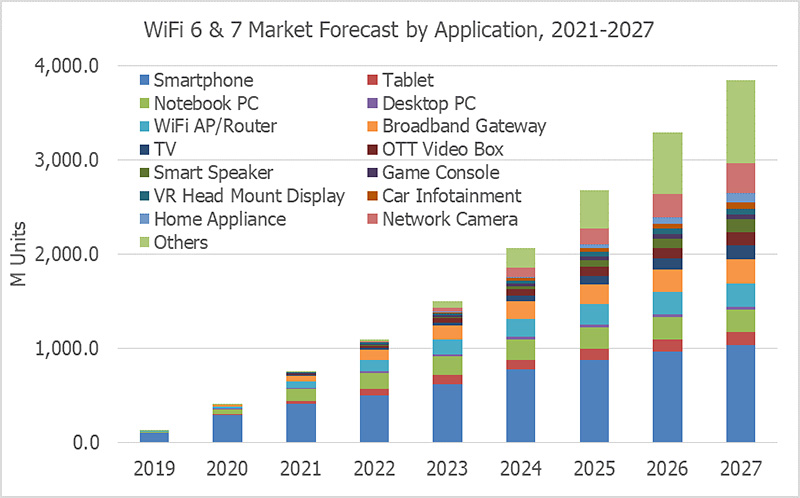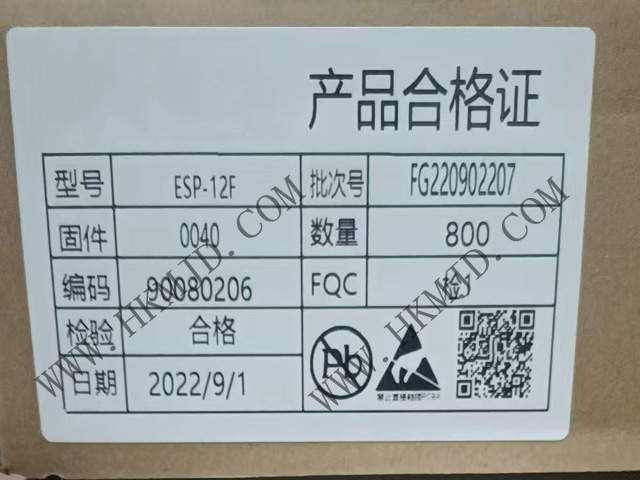Welcome Here Shenzhen Mingjiada Electronics Co., Ltd.

sales@hkmjd.com

sales@hkmjd.com

Service Telephone:86-755-83294757
 Latest Information
Latest InformationThis article will discuss the WiFi market and applications, with a special focus on the new WiFi 6E and WiFi 7 standards.
WiFi has been expanding its capacity and applications from computers and networks to mobile, consumer and IoT-related devices. The WiFi industry sets the WiFi 6 standard to cover low-power IoT nodes and broadband applications. WiFi 6E and WiFi 7 add new 6GHz spectrum to address higher bandwidth applications such as 8k video and XR displays. By improving interference and latency, the new 6GHz spectrum is also expected to be used for high-reliability industrial IoT use cases.
This article will discuss the WiFi market and applications, with a special focus on the new WiFi 6E and WiFi 7 standards.
WiFi Market and Applications
After strong market growth in 2021, the WiFi market is expected to grow by 4.1% to approximately 4.5 billion units in 2022. We forecast mid-single-digit growth through 2023-2027, reaching approximately 5.7 billion units in 2027. Smart home, automotive, and embedded IoT applications support growth in WiFi device shipments.
The WiFi 6 market started in 2019 and is growing rapidly in 2020 and 2022. WiFi 6 will account for about 24% of the total WiFi market in 2022. By 2027, WiFi 6 and WiFi 7 will account for about 2/3 of the WiFi market. 6GHz WiFi 6E and WiFi 7 will grow from 4.1% in 2022 to 18.8% in 2027.
The 6GHz WiFi 6E market will start to pick up in the US market in 2021, followed by the European market in 2022. WiFi 7 devices will start shipping in 2023 and are expected to surpass WiFi 6E shipments in 2025.
6GHz WiFi has huge advantages in broadband, gaming, video streaming applications, and specific industrial IoT use cases that require highly reliable, low-latency communications, such as factory robotic automation and AGVs. 6GHz WiFi also improves the accuracy of WiFi positioning.
However, there are two major challenges to 6GHz WiFi market deployment, spectrum availability and additional cost. 6GHz spectrum allocation policies vary by country. Under current policies, China and Russia will not allocate 6GHz spectrum for WiFi. The Chinese government is currently planning to use 6GHz for 5G. The absence of China, the largest WiFi market, will negatively impact future WiFi 7 market growth.
Another challenge for 6GHz WiFi is the additional cost of the RF front-end (broadband PA, switches and filters). The new WiFi 7 chipset will increase the cost of the digital baseband/MAC part to increase data throughput. Therefore, 6GHz WiFi will be mainly used in developed countries and high-end smart devices.
WiFi vendors will start shipping 2.4GHz single-band WiFi 6 chipsets in 2021 to replace legacy WiFi 4 widely adopted in IoT devices. New features like TWT (Target Wake Time) and BSS color benefit IoT devices by adding lower power operation and better spectrum usage. By 2027, 2.4GHz single-band WiFi 6 will account for 13% of the market.

In terms of applications, in 2019, WiFi access points/routers/broadband gateways, high-end smartphones, and PCs took the lead in adopting WiFi 6, which are still the main applications. In 2022, smartphones, PCs and WiFi network devices will account for 84% of WiFi 6/6E shipments. In 2021-2022, a wider range of WiFi applications will move to WiFi 6. In 2021, smart home devices such as smart TVs and smart speakers will begin to adopt WiFi 6. In 2022, home and industrial IoT applications and automobiles will begin to adopt the WiFi 6 standard.
WiFi networks, high-end smartphones and PCs are the main applications of WiFi 6E/WiFi 7. In addition, 8k TVs and VR headsets are also expected to be the main applications of 6GHz WiFi. In 2025, 6GHz WiFi 6E will be used in automotive infotainment and industrial automation use cases.
Single-band WiFi 6 is expected to be used in low-data-rate WiFi applications such as home appliances, home IoT devices, IP cameras, smart wearables, and industrial automation.
WiFi 6/7 Chipset
Qualcomm, Broadcom and Intel were the first to bring WiFi 6 chipsets to market in 2019, followed by Infineon (Cypress), NXP, MediaTek, ON Semiconductor, MaxLinear (Intel) and Renesas (Celeno) in 2020 Followed by. 2021-2022, Synaptics, Realtek, Espressif and Beken join the fray.
In 2021, Broadcom (smartphones, tablets, PCs, WiFi networking), Qualcomm (smartphones, tablets, PCs, WiFi networking) and Intel (PC) have a combined share of over 85% of the WiFi 6 chip market. However, the likes of MediaTek, NXP, ON Semiconductor and others have gained market share in 2021. As WiFi 6 adoption expands in wider applications, the market share of WiFi 6 chips will become more diverse.
The WiFi 7 chipset has been released in the second quarter of 2022, with the release of the WiFi 7 Draft 2 (WiFi 7 Release 1) standard. Qualcomm, Broadcom and MediaTek are the first to release WiFi 7 chipsets. Intel is also expected to release WiFi 7 chipsets in early 2023.
In the WiFi 7 chipset, MediaTek and Broadcom (for mobile devices) use 6/7nm advanced semiconductor process nodes. Due to the huge development cost required for 6/7nm IC design, this is an obstacle for small and medium-sized semiconductor companies to develop high-end WiFi 7 chipsets in the future.
For single-band WiFi 6 chipsets, Espressif leads, followed by Beken and AIC Semiconductor. Chinese IC vendor pioneers WiFi 6 adoption in IoT WiFi chipsets.

Time:2025-09-06

Time:2025-09-06

Time:2025-09-06

Time:2025-09-06
Contact Number:86-755-83294757
Enterprise QQ:1668527835/ 2850151598/ 2850151584/ 2850151585
Business Hours:9:00-18:00
E-mail:sales@hkmjd.com
Company Address:Room1239, Guoli building, Zhenzhong Road, Futian District, Shenzhen, Guangdong
CopyRight ©2022 Copyright belongs to Mingjiada Yue ICP Bei No. 05062024-12

Official QR Code
Links: